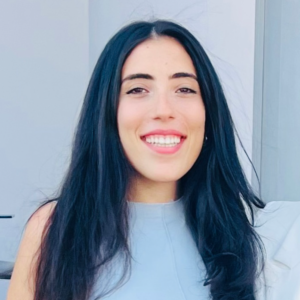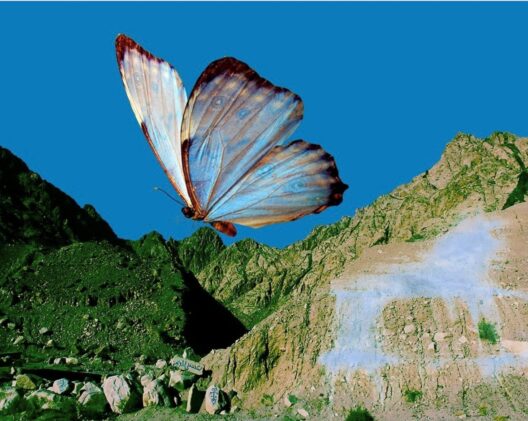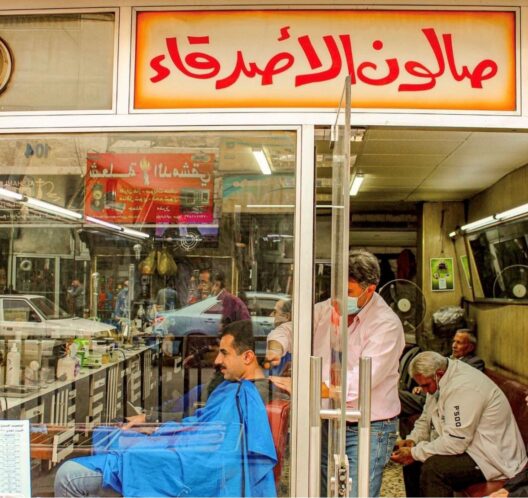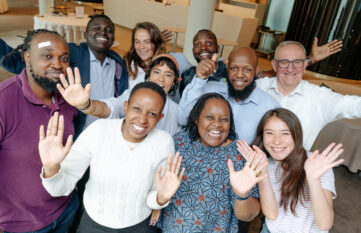From bored monkeys and comic cats to picture collages: unimaginable sums are currently paid for digital artworks known as non-fungible tokens (NFTs). But what exactly is the NFT hype all about? What consequences does it have for the global art market and what opportunities does it offer for artists from the Global South? An interview with Natalie Lama, a Web3 pioneer from Jordan and Lara Assi, a passionate Web3 consultant and educator from Lebanon.
Lara, as a passionate Web3 consultant and educator, could you briefly demystify Web3 for those who haven’t encountered it yet?
Lara: If you ask ten experts to explain what Web3 is, they will give you ten different answers! My explanation is that Web3, in simple terms, is the evolution of the internet as we know it today. Think of the current internet as a place where you visit websites and interact with applications owned by big companies. Web3, on the other hand, is a whole new digital landscape where ownership and control are in the hands of the end user, thanks to blockchain technology. In Web3, you are not just a user; you are a participant. You have the power to own digital assets like non-fungible tokens (NFTs), interact with other participants without intermediaries, and ensure that your activities are kept private and secure. In short, you have the freedom to explore, trade, and create in a way that was never possible before. You are in the driver’s seat!
What is the hype surrounding NFTs in Web3, and how do they transform art into digital assets of high value?
Lara: NFTs are like digital certificates of ownership for unique items on the internet, stored on a blockchain. It is as if you are buying a digital Picasso painting, and everyone can see you own it. When it comes to art, NFTs are a game changer. Artists can now create digital art, attach it to an NFT, and sell it directly to collectors. This means that artists get paid fairly for their work, and collectors have proof of ownership which can make the art more valuable over time. NFTs are like the new currency of the digital art world, making it easier and more profitable for artists to monetise their work through a global portal.
What makes Web3 a game changer for the creative economy?
Lara: Web3 plays a pivotal role in the creative economy by introducing unprecedented opportunities for artists and creators. It offers a decentralised structure where creators can directly monetise their art and engage with their audience, cutting out intermediaries. Creators shifting to Web3 are being empowered by having more control over their content and finances, fostering a more equitable and sustainable ecosystem for the creative economy.
Natalie, please share your experience of how you became a Web3 artist and what NFTs mean to you.
Natalie: My journey as a Web3 artist has been an exciting evolution. First, I was trying to sell my photography prints here in Jordan. However, my artwork challenges the social norms of the Arab world, resulting in several local galleries and exhibitions declining to display my work. In 2021, I discovered Web3 through a friend, which enabled me to share my work as NFTs without being censored or judged. Web3 gave me access to meet international collectors and artists that I would not have met in the traditional art market. Since then, I have sold two collections, participated in Kuwait’s First NFT art exhibition, NFT NYC, and various Metaverse exhibitions.
What is your opinion regarding the NFT controversy? Additionally, what do you perceive as the primary obstacles for individuals interested in entering the Web3 realm?
Lara: Yes, the scepticism is definitely there. If we look closer, we realise that it springs from crypto scepticism and misinformation. I can assure you that the Web3 fight is much more than societal perception, but rather with tech giants. We have been the product for so long that tech giants and the people in power are actively working on tarnishing Web3’s decentralisation aspect by linking it to illegal activities. All sectors are prone to corruption and illegal practices, as we humans dictate the desired output of technology. I would tell people to DYOR (do your own research) and not be swayed by general sentiments. I believe that the main pain point for people to enter Web3 is the technical barrier that they are faced with. Setting up digital wallets, understanding how to trade or mint NFTs, and understanding the Web3 ecosystem are enough to overwhelm newcomers. That is why I am passionate about Web3 education.
How does the emergence of Web3 affect the participation of women in the international art market, and what cultural challenges do they encounter?
Lara: Web3 has democratised the global art market by lowering barriers to entry. Because of Web3’s global reach, female artists can access a global audience without geographical limitations traditionally associated with the art market. For so long, women from where I come from, had to always play nice and never cross any line that might upset the paternal patriarchal system. What is significant about Web3 is that women can now express themselves the way they want and portray their art to a global like-minded community from the comfort of their homes. Look at Natalie’s work. Our society would never accept such a progressive art, let alone support it. Natalie found her community, and they in turn found her art. Her collections were sold out! Thank you Web3.
Natalie, could you please describe your experience of being an NFT artist in Jordan?
Natalie: Being an NFT artist in Jordan carries a unique significance. I’m proud to be part of a growing community of digital creators in my country. It implies breaking new ground, pushing the boundaries of what’s possible in the art scene here. It also means I have the responsibility as an artist to introduce NFTs to my community as it is the future and opens doors to job opportunities that people still do not know about.
“I’m proud to be part of a growing community of digital creators in my country. It implies breaking new ground, pushing the boundaries of what’s possible in the art scene here. [NFTs are] the future and open doors to job opportunities that people still do not know about.”
Natalie Lama
What are your aspirations for the NFT communities within your country and region?
Natalie: My aspiration is to foster a vibrant and supportive NFT community both in Jordan and the wider region. By connecting with fellow artists and enthusiasts, we can collectively propel this movement forward. I hope to see more local talent emerge and thrive in the NFT space.
Lara, is the sense of community in Web3 different from that experienced in other aspects of life?
Lara: In the realm of Web3, the idea of a community transcends the boundaries of time, space, and culture. Community is the underlying infrastructure. Without community, there is no Web3. The whole concept of decentralisation lies behind empowering individuals (not corporations) to have a say in things. To participate and get rewarded. To transform from a passive consumer to an active stakeholder. This is incredibly empowering, especially for those who feel left out or marginalised.
How do Web3 communities for women support aspiring artists?
Lara: Women in Web3 are big on onboarding more women into the space. Seasoned artists and industry leaders willingly and eagerly share their knowledge and experience. I for one have been mentored by great women in this space. In Web3 female communities, you find this unprecedented dynamic exchange of ideas that propels women’s talents to a new height. These communities are safe and welcoming, inviting women to freely express themselves and seek guidance. These communities are working collectively to break down barriers, shatter stereotypes, and provide a nurturing environment for aspiring female artists to flourish.
“In Web3 female communities, you find this unprecedented dynamic exchange of ideas that propels women’s talents to a new height. […] These communities are working collectively to break down barriers, shatter stereotypes, and provide a nurturing environment for aspiring female artists to flourish.”
Lara Assi
Natalie, as the forerunner of Jordan’s inaugural NFT art exhibit, could you elaborate on your encounter, obstacles faced, and the reception by your audience?
Natalie: Initiating the first NFT art exhibition in Jordan was a groundbreaking experience. The NFT exhibition was tailored to artists from the Middle East and North Africa region. However, several artists from around the world participated in the open call. We faced some challenges, such as navigating the artwork on the screen (they were very large screens). It was refreshing to also have support from Web3 experts from Lebanon that have done NFT exhibitions before. The resonance and interest we received after the exhibition was incredibly positive. A lot of people were very curious after the exhibition, they would approach us and ask about NFTs and how it all works. It was inspiring to see the local and regional community come together to celebrate digital art and NFTs.
What were the key points to take away from your participation in the Cultural and Creative Industries Conference in Amman, Jordan in September 2023, which included your attendance at the NFT art exhibition and panel discussion/workshop?
Lara: What an experience! I cannot even explain how heart-warming it was to see the Jordanian youth’s thirst for Web3 knowledge. I enjoyed steering the panel. We ended up going 15 minutes over the time limit to be able to answer all the audience’s questions. We tried to go easy on the technicalities as much as we could, only to find out that the attendees wanted to know more. Also, we might have initiated the first Web3 community in Jordan! The exhibition’s turnout was beyond our expectations. My personal highlight of the whole exhibition was seeing the proud faces of Jordanian NFT artists and how eager they were to share their digital art with their friends and families.
The opinions expressed in this interview are the sole responsibility of the interviewees and do not necessarily represent the official position of the GIZ. The interview has been conducted by the Global Project Culture- and Creative Industries.

Lara Assi is a seasoned Web3 consultant and educator hailing from Beirut, Lebanon. Her expertise in Web3 began with immersive technologies, and she later transitioned to digital assets and decentralised applications. After her upbringing in Saudi Arabia, she has gained diverse experiences through living in the Ivory Coast and London. Lara is committed to empowering women in tech, promoting financial independence, and fostering diversity in the Web3 realm.

Jordanian-born Natalie Lama is an up-and-coming NFT artist. Her latest compilation, “My Escapism”, has received international acclaim. Her pieces effortlessly depict the concept of detaching oneself from reality by expertly capturing this dissociation through her evocative photographs of Jordan’s natural environment. This results in a vivid and captivating personal reality that she can escape to from the mundane world.





